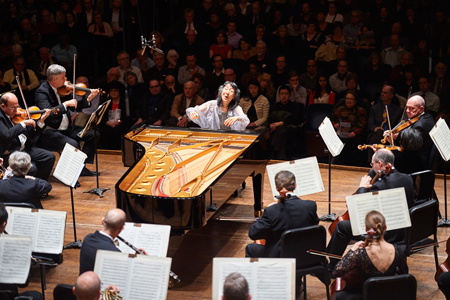by Nicholas Jones

Uchida is well known in Cleveland. She was artist-in-residence with the Orchestra from 2002 to 2007, has come back many times to play and conduct, and is currently recording a number of Mozart’s concertos with them. The warm reception from the almost-capacity crowd made it clear that Uchida’s frequent returns are welcome.
This program’s two concertos represent the beginning and end of a three-year period (1784-86) when Mozart composed a wealth of works for piano and orchestra, pieces in which he could show off — and profit from — his status as a keyboard star. One hopes that the audiences who obviously loved his exuberant pianistic style also recognized how sophisticated the compositions were.
The concert opened with the concerto in G major, K. 453 (No. 17 in the current numbering scheme of Mozart’s piano concertos), a graceful work that subtly infuses elegance with surprise, and balance with uncertainty and tension.
Playing at the center of the orchestra and conducting with unorthodox but effective gestures from the keyboard, Uchida made the most of Mozart’s turns of mood and shifts of color. Appropriately tasteful when it mattered, she was also not afraid to make the piano sound brash or even rude, nor was she shy about asking the orchestra to do the same. Hands leaping off the keyboard to conduct, she would energetically shape an orchestral interlude — now jubilant, now playful, now mysterious — so that it set up the next entrance of the piano.
A reduced chamber group (the string sections about half their usual size) accompanied Uchida in the concertos. It should be no slight to the string sections, who played with their expected precision and stylishness, to say that it was the woodwinds who particularly shone in this collaboration. Seated right at the end of the piano, a single flute and pairs of oboes, horns, and bassoons played with chamber-music intimacy, sustaining important notes, luxuriating in suspended dissonances, and generally supplying the darker colors that bring depth and seriousness to this sprightly and often playful concerto.
The other piano concerto, No. 25 in C major, K. 503, followed intermission. Here Mozart adds drums and trumpets to the mix, and the stirring bombast that adds to the writing was delivered resoundingly by the combined forces. The piano matched them with a crisp and powerful tone. As in the G-major concerto, the orchestra never overwhelmed the piano. Even the horns and trumpets, naturally loud instruments, were integral to the feeling of collaboration and balance.
In the finale, a breezy rondo with the potential to be a superficial closer, Mozart also throws in some wonderful surprises. He builds contrast into the dazzling piano figuration, a mix of scales and arpeggios with a complicated rhythmic interplay (eighth notes, triplets, sixteenth notes, in unpredictable sequences) and a liberal interjection of accidentals — what one might call “blue” notes. And again, just as we might think we are wrapping up in a flurry of finale gestures, the piano slows the pace with a simple lyrical tune, leading into a breathtakingly beautiful quartet with flute, oboe, and bassoon, one of Mozart’s great moments of mystery. It reminded me of the finale of The Marriage of Figaro, where the count, who’ s been a bad boy, kneels and asks forgiveness of his wife.
Between the two concertos, the orchestra played Mozart’s Symphony No. 34 in C, K. 338, without a conductor. The piano having been moved to the side, the smallish orchestra played in close formation, the eight first-desk string players in a tight arc. Concertmaster William Preucil energetically delivered cues, and given the distance between him and the back row of drums and trumpets, rhythms and dynamics were surprisingly tight. But overall the performance lacked the nuance and character of the concertos, aspects that a conducted version might have revealed. Soft passages were not soft enough; the inner voices, particularly, had a tendency to over-balance the others. The second movement, for strings alone, lacked the intense intimacy that its delicate timbres might have evoked.
I sensed a certain excitement in the orchestra as each member of the group clearly took responsibility in a way they may not when a conductor is at the podium. But was it wise programming to pair an unconducted Mozart symphony of arguably lesser quality with two such sophisticated concertos? Another piece for chamber orchestra (modern, or even contemporary) in a different idiom might have been more effective. Mozart himself knew so much about contrast and surprise.
Photo by Roger Mastroianni, courtesy of The Cleveland Orchestra.
Published on ClevelandClassical.com February 14, 2016.
Click here for a printable copy of this article



